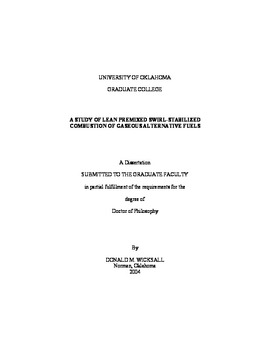| dc.contributor.advisor | Agrawal, Ajay K., | en_US |
| dc.contributor.author | Wicksall, Donald M. | en_US |
| dc.date.accessioned | 2013-08-16T12:19:32Z | |
| dc.date.available | 2013-08-16T12:19:32Z | |
| dc.date.issued | 2004 | en_US |
| dc.identifier.uri | https://hdl.handle.net/11244/787 | |
| dc.description.abstract | The burner was constructed of 1.5&inches; (3.8 cm) schedule 40 steel pipe. Fuel injectors were placed 40 cm upstream of the burner to ensure that the fuel and air were fully premixed prior to combustion. The fuel air mixture entered the combustion chamber in the annulus around a centerbody which contained 6 swirl vanes to impart an out of plane motion to the flow. The flow expanded into the combustion chamber which had an 8.1 cm inside diameter, and was exhausted into the ambient at the end of the combustion chamber. Pollutant emissions were measured using an electro-chemical gas analyzer and water-cooled stainless steel and expansion-cooled quartz probes. Flame extinction was studied by visual observation of the flame. Combustion related noise was recorded using a condenser microphone and digitized by a high speed data acquisition card. (Abstract shortened by UMI.) | en_US |
| dc.description.abstract | The effects of utilizing gaseous fuels with different compositions was studied for a lean premixed swirl stabilized burner typical of those used in land-based gas turbine engines. The experiments were performed at atmospheric temperature and pressure in a quartz glass combustor. The fuels utilized were binary mixtures containing either methane or propane as the primary component and hydrogen, oxygen, nitrogen or carbon dioxide as the secondary component. The combinations chosen represent constituents of various gaseous alternative fuels. In particular, focus was placed on hydrogen enriched hydrocarbon fuels proposed as a cross-over strategy to the hydrogen energy infrastructure. The operating parameters included fuel composition, total reactant flow rate, and the calculated adiabatic flame temperature. Global flame characteristics such as emissions of oxides of nitrogen (NOx) and carbon monoxide (CO), flame extinction, and combustion noise were studied. The internal characteristics of flames were also studied, including the velocity field and related flow properties, as well as the structures of the reaction zones. | en_US |
| dc.format.extent | xxii, 212 leaves : | en_US |
| dc.subject | Flame. | en_US |
| dc.subject | Fuel switching. | en_US |
| dc.subject | Engineering, Mechanical. | en_US |
| dc.subject | Combustion. | en_US |
| dc.subject | Gas-turbines Combustion chambers. | en_US |
| dc.title | A study of lean premixed swirl-stabilized combustion of gaseous alternative fuels. | en_US |
| dc.type | Thesis | en_US |
| dc.thesis.degree | Ph.D. | en_US |
| dc.thesis.degreeDiscipline | School of Aerospace and Mechanical Engineering | en_US |
| dc.note | Source: Dissertation Abstracts International, Volume: 65-08, Section: B, page: 4257. | en_US |
| dc.note | Adviser: Ajay K. Agrawal. | en_US |
| ou.identifier | (UMI)AAI3143547 | en_US |
| ou.group | College of Engineering::School of Aerospace and Mechanical Engineering | |
